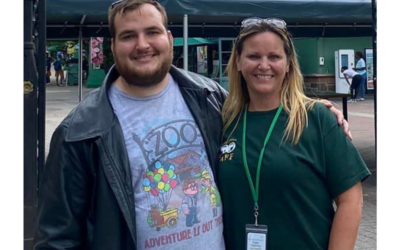We’re pleased to share a guest essay by Sophie Plant-Darling. Sophie is a student in the Project Dragonfly Masters program through Miami University of Ohio – specifically, Sophie was one of my students in Belize last summer. While on this field expedition, Sophie formed her early ideas of studying burnout within the conservation field. This issue has become increasingly relevant in the past few years and if not addressed, could have troubling consequences for our field. Here, Sophie shares some of her experiences with burnout and avenues for healing. –Kathayoon Khalil, PhD
As a person working in a conservation or wildlife care profession, imagine if you were given a dollar every time you were told “You have the coolest job!”, or asked “So, how much do you love your job?” For me, I was never lying when I agreed wholeheartedly, but over the years the other half of my answer that tucked in the back of my mind got louder and bigger. “I agree, it IS amazing! I love working with these animals!… I’m also exhausted and overwhelmed. We’re understaffed. We’re underpaid. I have terrible insomnia. My stress levels are through the roof…”
As I believe is the case for many of us that work in this field, my motivation in pursuing a career in conservation and wildlife care was found in the compassionate nature of the job. I find innate reward and value in creating connections with nature and wildlife. Unfortunately, this passion and drive, when mixed into a career, does not lend itself to a healthy work-life balance. When this goes too far, you have a perfect recipe for burnout.
In the beginning of 2022, I decided to leave my position as sea lion supervisor at the Houston Zoo and focus on my health and graduate studies. Over the last 18 months in Miami University’s Project Dragonfly program, I found myself wanting to understand the correlation between strengthening personal connection to nature and its impacts on burnout. Given my experience in the conservation and wildlife care field, I was particularly interested in how this impacts my peers. Nature, art, and general mindfulness have been researched and consistently shown to be effective tools to combat and prevent burnout and decrease stress. However, with nature at the heart of the work we do, how does that impact its use as a burnout therapy tool?
In the summer of 2021, I started focusing on this question in my graduate work. While there is so much work left to do, I want to communicate as best I can to others experiencing symptoms of burnout that you are not alone. I needed encouragement, support, and creative solutions from my peers, and I want to offer that to our community.
I’ve talked to my peers and colleagues in the field and have found the tactics below to be the most common tools to keep burnout at bay and reconnect with what you love. [Zoo Advisors has included select online resources as reference. Click on the italicized article titles to view.]
Walking, but with a perspective shift
Use this walk to be present in the outdoors, without focusing too much on what you’ll make for dinner or how much dog hair has accumulated under your bed. Even in dense cities, where we often forget about the nature around us, put intention into noticing what ecosystems are flourishing right under your eyes. You can stay on the move and focus on the big picture or take breaks and focus on what activity and life may be bustling around a small area. Listen.
Walk-on: Your Mental Health and the Power of Walking
Explore art
Consider the natural world around you with art. Try your hand at photography (even with your smartphone!), sketching, painting, or collage. Art can be an amazing tool for shifting our perspective and paying attention to the small details in the world around us.
Work to release judgment when you’re practicing; let your mind wander but acknowledge unnecessary and irrelevant thoughts and move past them.
The Mental Health Benefits of Art
Creativity and Recovery: The Mental Health Benefits of Art Therapy
Become a plant parent
Over the last three years of the pandemic, we saw a few activities trending; baking and breadmaking, Zoom happy hours, Animal Crossing… and plant parenting. Having plants in your home brings nature into your immediate environment and provides a multitude of mental health benefits. Having indoor plants has been shown to reduce stress levels, boost productivity, improve air quality, and may even contribute to speedier recovery from illness.
How Indoor Plants Can Help with Mental and Emotional Health
Five Easy Houseplants to Love, Based on Your Mental Health Needs
Level up your plant parenting – take it outdoors with a pollinator garden
Take your newfound green thumb just outside your door and boost your conservation action! Whether you have a few potted native pollinator plants on your doorstep or balcony, or a full-blown pollinator garden, gardening for pollinators like bees and butterflies supports local ecosystems and continues to grow your personal connection to nature.
Climate-Resilient Pollinator Gardens
Take your daily activities outside
As we move into spring and summer, this is the perfect opportunity to move into the outdoors. Set a table for one, make a dinner party out of it, or create a picnic and have a meal outside. Find a space and take your workout out in the fresh air. Have your weekly catch up calls with your mom on a walk around your neighborhood.
Nature-based Activities Boost Mood and Limit Anxiety, New Study Confirms
Nurtured by Nature
Bird watching
No matter where you are – hiking trails, high-rise building balconies, city parks – there will always be birds. Find a place where you can watch what birds come in and out of your scene. Note their behavior, flight patterns, social interactions, or even make up stories about them.
Birding for Well-being: How Connecting with Nature Can Improve Mental Health
Mental Health Benefits of Birdwatching
Choosing to leave the zoo was an incredibly difficult and personal decision. I’ve spoken to and heard from many other individuals in our field that often wrestle with the same dilemma – the pull between self-care and our careers, the love of our work and the love for ourselves. After 15 years working as an advocate and caretaker for these animals, I struggled with feelings of selfishness around stepping away and prioritizing my need for rest, nearness to my family, and an environment that brings me peace. Leaving the job is not going to be a solution or a step along the journey for everyone, and I only want to encourage and remind others in our community that our welfare is also important. We need to care for ourselves as much as we do our work and our animals.
Making the effort to prioritize ourselves and fight the terrifyingly easy slide towards burnout isn’t selfish. It doesn’t diminish the work we do, nor take away from the level of care and dedication that we provide. It does the exact opposite. Truly connecting with ourselves and creating a space of kindness in a world where we’re working ourselves to the brink is important. Taking that time for ourselves with no other purpose than to just be calm and mindful and find joy in nature may be what saves us.
Sophia Plant-Darling has worked with sea lions for 15 years, and recently left her position as a Senior Supervisor of Sea Lions at the Houston Zoo. This article is inspired by and a part of her graduate work with Project Dragonfly at Miami University in Oxford, Ohio.





